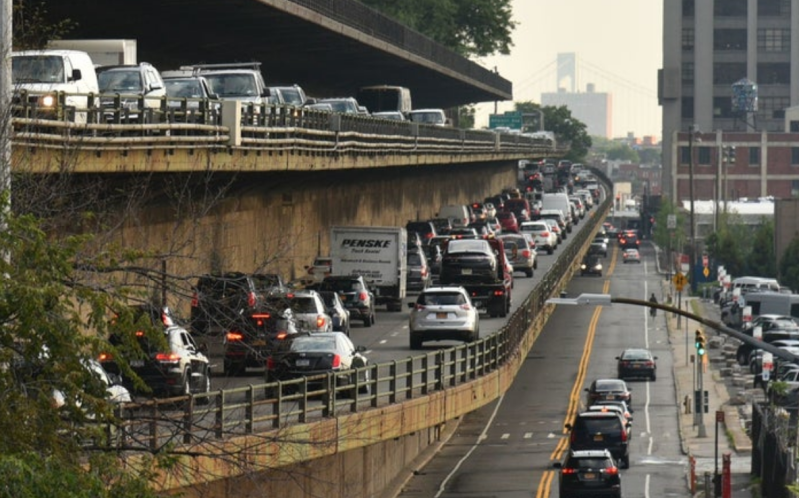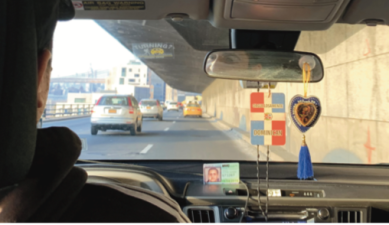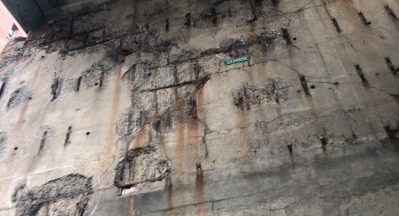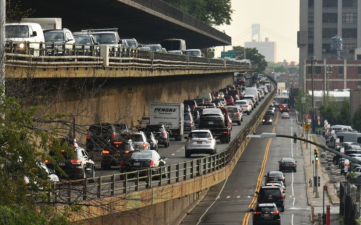The Mayor Doesn’t Agree With His Own ‘Expert’ Panel To Nix Two Lanes On BQE

Mayor de Blasio is walking away from his own “expert” panel’s central recommendation for fixing the beleaguered Brooklyn-Queens Expressway because he believes the disproven fallacy that eliminating lanes of traffic adds to congestion, instead of actually reducing it.
The 16-person panel that Hizzoner tapped last April to come up with an alternative for repairing the 1.5-mile, triple cantilevered stretch under Brooklyn Heights said in its report that the city must nix two of the expressway’s six lanes of traffic in order to reduce the number of gas-guzzling vehicles that rumble across it every.
The panel also decreed that repair work must begin immediately, and that the number of trucks must be limited on the roadway — before it collapses beneath their weight within five years.
On Friday morning, de Blasio disputed the panel’s main suggestion, buying into the false narrative that creating more space for cars reduces traffic — a theory dispelled by the proven phenomenon known as induced demand.
“We have to be careful [if] we reduce, the amount of lanes,” de Blasio said during his weekly appearance on WNYC’s Brian Lehrer show. “The problem I have with that is one, that’s not a guarantee that people get out of the cars. It is a guarantee of traffic jams and it is a guarantee of other challenges.”
https://twitter.com/BrooklynSpoke/status/1223262939664261120
Fortunately, de Blasio’s own panel — which he created to get the BQE done “right” after his administration proposed two much-reviled plans — understands the concept of induced demand, and referenced it as its reasoning for recommending cutting two lanes of traffic.
The panel was advised by transportation and engineer expert Sam Schwartz, who explained to the also-confused New York Times the notion of “if you build it, they will come,” as it relates to the demand for cars.
“We’ve gone through a 70-year period of adding and widening but this is a failing strategy. It’s like solving the obesity problem by loosening your belt,” said Schwartz, aka “Gridlock Sam.”
The Department of Transportation’s two initial proposals would have just rebuilt the six-lane highway as is, and one would have temporarily replaced the Heights’s fabled Promenade with a six-lane speedway for at least six years of construction.
The panel said it rejected any proposal to build a temporary highway over the beloved walkway.
It was supposed to come up with a recommendation for the city over the summer, and then before the end of the year, before finally dropping its 72-page report on Thursday via a Times article that transit advocates critiqued as more fiction than fact.
Here in 2020, The New York Times Metro Section seems to think adding lanes to highways is a way to reduce traffic. They haven't actually cited a transportation expert, and the only one on record in the article says the exact opposite. So I assume it's the paper's view. pic.twitter.com/sn0dMCH3AG
— Second Ave. Sagas (@2AvSagas) January 30, 2020
The Times story did not mention the well-established concept of induced demand, a long-proven notion that widening highways only leads to more congestion as drivers fill up the newly created space. In fact, the Times story argued that the panel’s proposal to put the BQE on a road diet “would run counter to established traffic management policies to expand highways in response to greater demand, according to transportation experts.” (Reporter Winnie Hu’s story, alas, quotes no transportation experts actually saying that, by the way).
In fact, current trends are moving in the direction away from widening highways and towards eliminating them. In Seattle, the Alaskan Highway viaduct carried 90,000 cars per day before it was closed entirely in January, 2019. Local reporters from the Winnie Hu school predicted a car-pocalypse on local streets, but it did not happen because drivers found other routes.
“Our travel times have actually been better than when we had the Alaskan Way Viaduct and everyone was commuting in their normal way,” KIRO Radio Traffic Reporter Chris Sullivan told MyNorthwest. “I’m still trying to figure out where those 90,000 cars went that usually use the viaduct.”
The Seattle Times put it more succinctly: “The cars just disappeared.”
It’s not like New York City doesn’t have any experience with induced demand’s successful brother, reduced demand: On 14th Streets, private cars have been dramatically restricted — but side streets are not filled with the overflow. Drivers have simply gone somewhere else.
So what does the panel ultimately recommend?
The panel suggests cutting the number of lanes in each direction on the BQE, including through the triple-cantilever stretch from Atlantic Avenue to Sands Street from three to two, which it says could reduce traffic volumes by 15 percent, from the current 153,000 vehicles to about 125,000. It also recommends that the city immediately begin to enforce existing restrictions on overweight trucks, which the NYPD will do, beginning on Monday.
The new NYPD BQE Truck Enforcement Task Force will slap drivers behind the wheel of trucks 80,000 pounds or more with fines up to $7,000 per violation, de Blasio said.
The mayor also announced that DOT will begin repairs in the spring to the crumbling retaining wall along Hicks Street, and other sections of the cantilever, and hopes to wrap that up by the end of the year. In addition, DOT will begin the design process on the repairing the most rapidly deteriorating portions of the triple cantilever this summer, and expects that work to be completed by the end of 2022.
Other recommendations from the panel include coming up with a so-called transportation management plan to address changing travel patterns throughout construction, diverting some traffic to the Williamsburg Bridge, and using forthcoming congestion pricing tolls to make using the BQE less desirable.
How does it compare to other plans proposed?
The panel’s chairman, Carlo Scissura, said the group did not discuss the possibility of tearing the highway down entirely — an idea put forward by transportation advocates, Streetsblog, and even once touted by Council Speaker Corey Johnson. Nor did the panel look at making the highway truck-only — another plan pitched by Comptroller Scott Stringer, who wanted to ban all cars on the BQE and cover it with park land.
“We want to see a full new plan from the Verrazano Bridge all the way into Queens,” said Scissura. “What we’re saying is the government needs to come together to rebuild this entire road.”
The panel’s proposal most closely aligns with ones previously put forward from the powerful Brooklyn Heights Association, and another local group, A Better Way, which tapped the Regional Plan Association — both similarly called for nixing two-lanes of traffic on the highway in an effort to help break the city’s car culture; and another plan from the world-renowned architecture firm Bjarke Ingels Group, which called for a six-lane roadway that would allow for the same amount of traffic, decked over with a linear park.
But the panel’s recommendations for immediate repairs and reducing lanes of traffic are now just that, and are only temporary fixes — the Department of Transportation still must sign off on a long-term plan for the BQE, which de Blasio says the city is still considering.
“There were a lot of good counter proposals, but the one thing we have to do is make a decision on this as a city and act on it because we can’t just do this, you know, as a ‘Band-Aid.’ We can’t do this in small pieces. Ultimately, there has to be a bigger solution here,” Hizzoner said Friday. “But then we have to get onto the work of figuring out the long-term solution and the panel put together a number of I think, thoughtful ideas about how to do that. We’ve got to figure out how to get those ideas assessed pretty quickly so there can be action taken.”



